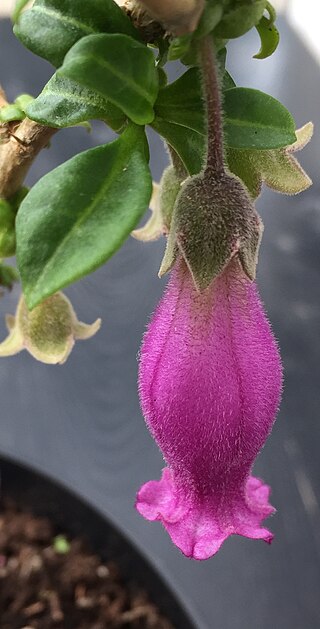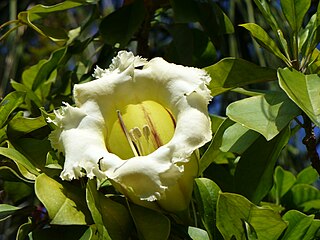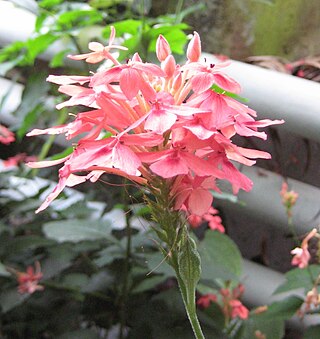
Genipa is a genus of trees in the family Rubiaceae. This genus is native to the American tropical forests.

Streptosolen is a monotypic genus of flowering plants in the family Solanaceae. It is closely related to the genus Browallia, within which it was originally placed. The single species, Streptosolen jamesonii, the marmalade bush or fire bush, is an evergreen shrub bearing loose clusters of flowers which change gradually from yellow to red as they develop, resulting in an overall appearance resembling orange marmalade, found in open woodlands in Colombia, Venezuela, Ecuador, and Peru. In its native Ecuador, the plant has the Spanish common names flor de quinde, flor del sol and jaboncillo.

Nicandra physalodes is a species of flowering plant in subfamily Solanoideae of the nightshade family. It is known by the common names apple-of-Peru and shoo-fly plant. It is thought originally to have been native to western South America, including Peru, and is known elsewhere as an introduced and ruderal species – sometimes as a weed – in tropical, subtropical and, to a lesser extent, temperate areas all over the world. It has also long been cultivated as an ornamental plant for its attractive flowers and curious fruits and has been adopted into the traditional medicine of countries far-removed from its original home.

Datura metel is a shrub-like annual or short-lived, shrubby perennial, commonly known in Europe as Indian thornapple, Hindu Datura, or metel and in the United States as devil's trumpet or angel's trumpet. Datura metel is naturalised in all the warmer countries of the world. It is found notably in India, where it is known by the ancient, Sanskrit-derived, Hindi name dhatūra (धतूरा), from which the genus name Datura is derived.

Scopolia is a genus of four species of flowering plants in the family Solanaceae, native to Europe and Asia. The genus is named after Giovanni Scopoli (1723–88), a Tyrolean naturalist. The genus has a disjunct distribution, with two recognised species in Central to Eastern Europe,, and two species in East Asia. The two European species are:

Schizanthus, also called butterfly flower, fringeflower, poor-man's-orchid, is a genus of plants in the nightshade family, Solanaceae.

Brunfelsia portoricensis, the Puerto Rico raintree, is a species of flowering plant in the family Solanaceae. It is endemic to Puerto Rico, where it occurs in El Yunque National Forest.

Latua pubiflora(Griseb.) Baillon, is the single species of the monotypic genus LatuaPhil., endemic to the coastal mountains of southern Chile. A shrub or small tree to 10 m in height, bearing attractive, magenta-to-red, hummingbird-pollinated flowers, it is extremely poisonous – hallucinogenic (deliriant) in smaller doses – due to tropane alkaloid content and is used by Chilean machi (shamans) of the Mapuche–Huilliche people in traditional medicine, as a poison and to enter trance states. Its elegant flowers and yellow tomato-like fruit are attractive enough to merit its cultivation as an ornamental.

Brunfelsia pauciflora is a species of flowering plant in the family Solanaceae, the nightshades. It is endemic to Brazil, and it is grown in cultivation. A shrubby perennial plant grown in gardens, its common names include today, tomorrow together, yesterday, today and tomorrow, morning-noon-and-night, kiss me quick, and Brazil raintree.

Iochroma arborescens is a species of flowering plant in the genus Iochroma, belonging to the nightshade family Solanaceae. Formerly it was considered the single species in the monotypic genus Acnistus. Common names include gallinero, mata-gallina, fruta-de-sabiá, hollowheart, wild tobacco, siyou, bastard sirio, galán arbóreo, tabaco de monte, nigüito, marieneira, güitite, and tabak djab.

Solandra grandiflora, the showy chalicevine, or papaturra is a member of the nightshade genus Solandra and, like the other members of the genus, is a climbing plant with large, attractive, trumpet-shaped flowers. It is native to Central America and northern South America and is widely grown in the tropics as an ornamental. The green parts of the plant are highly toxic, due to tropane alkaloid content, and have caused deaths from anticholinergic poisoning, but the flesh of the ripe fruit is said to be edible. The fruits, which are globular and largely enclosed by the accrescent calyces, can reach a kilogram in weight and have a taste described as apple-like or melon-like.

Brunfelsia latifolia, commonly known as yesterday-today-tomorrow and kiss me quick, is a species of flowering plant in the nightshade family. Endemic to Brazil, it is an evergreen shrub that becomes semi-deciduous in cooler areas and grows up to 1.8 meters in height.
Timothy Charles Plowman was an ethnobotanist best known for his intensive work over the course of 15 years on the genus Erythroxylum in general, and the cultivated coca species in particular. He collected more than 700 specimens from South America, housed in the collection of the Field Museum of Natural History. The standard author abbreviation Plowman is used to indicate this person as the author when citing a botanical name.

Brunfelsia plowmaniana is a species of flowering plant of the nightshade family that is native to the cloud forests of the Bolivian and Argentinian Andes. It was first described in 2012 on the basis of systematic DNA barcoding of specimens from the genus Brunfelsia. Specimens belonging to the new species had previously been placed in the polymorphic species B. uniflora, which a molecular phylogeny revealed as polyphyletic.

Mecardonia (axilflower) is a genus of herbaceous plants in the family Plantaginaceae. 31 species have been described, of which 12 are accepted. Its distribution is predominantly in South America, and South East United States, including Florida and Alabama but may be found as far north as Virginia. (see map) Five species are found in Argentina and three in the US.
Mandragora turcomanica, the Turkmenian mandrake, is a perennial herbaceous plant in the family Solanaceae, native to the Köpet Dag mountains in Turkmenistan and one location in neighbouring Iran. It differs from the mandrakes found around the Mediterranean chiefly by being larger.

The Solanaceae, or the nightshades, are a family of flowering plants that ranges from annual and perennial herbs to vines, lianas, epiphytes, shrubs, and trees, and includes a number of agricultural crops, medicinal plants, spices, weeds, and ornamentals. Many members of the family contain potent alkaloids, and some are highly toxic, but many—including tomatoes, potatoes, eggplant, bell and chili peppers—are used as food. The family belongs to the order Solanales, in the asterid group and class Magnoliopsida (dicotyledons). The Solanaceae consists of about 98 genera and some 2,700 species, with a great diversity of habitats, morphology and ecology.

Petunioideae is a subfamily of the flowering plant family Solanaceae, the nightshades. It contains thirteen genera, as follows:

Atropanthe is a monotypic genus of flowering plants belonging to tribe Hyoscyameae of subfamily Solanoideae of the family Solanaceae.

Ruspolia is a genus of flowering plants belonging to the family Acanthaceae.


























